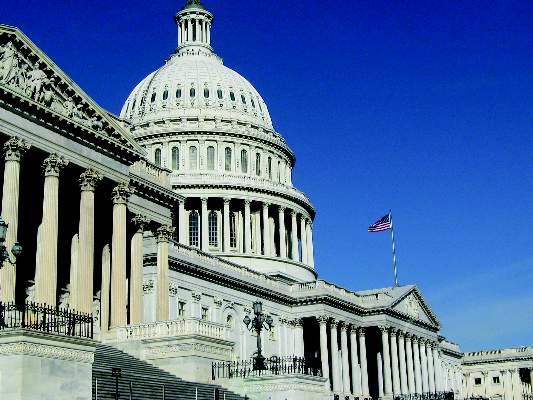User login
The year is ending on a sour note for physicians, as Congress is recessing without addressing the Medicare Sustainable Growth Rate formula or acting on a number of other doctors’ priorities.
Congress did not extend a pay increase for primary care physicians who serve Medicaid recipients, nor did it delay the implementation of the ICD-10 code set nor enact any legislative solutions to help physicians better grapple with meaningful use of health information technology.
Physicians held out hope until the closing days of the 113th Congress, as legislators battled over what would be put into a massive spending bill that was needed to keep the government in operation beyond Dec. 11. That $1.1 trillion bill was approved by the House just before the government was to run out of money, and by the Senate two days later.
Physicians were not able to point out much that was positive in either the spending bill or the 2014 legislative session.
“We’ve had a Congress that’s just been much more interested in fighting with each other than with constructing meaningful legislation,” Dr. R. Mack Harrell, president of the American Association of Clinical Endocrinologists, said in an interview. “For physicians that means we’re stuck with an SGR system that everyone agrees is just not good for health care and not good for patients.”
Many physician groups said that the failure to repeal the SGR was their biggest disappointment.
“We were cautiously optimistic that this seventeeth year of trying to repeal the SGR might have been the successful one,” Dr. Patrick T. O’Gara, president of the American College of Cardiology, said in an interview. He said that the sticking point seemed to be that “there was no politically viable way to pay for it.”
American College of Physicians President Dr. David A. Fleming noted in a statement that finding the money had hung up what otherwise was huge progress: a bill that members of the House and Senate, Republicans and Democrats had put together, and that ultimately passed the House.
The current SGR patch expires Mar. 31, 2015, giving physicians little time to convince a new Congress of the merits of replacing the formula.
Noting that there is about 37 days between when the new Congress begins in January and when a 21% pay cut goes into effect in April, American Medical Association President Robert M. Wah, said in an interview, “We’re already really up against the end of the current patch.”
Even so, physician groups say that they’ll try to start where they left off – with the bill that had gained such widespread support 2014. “We fully expect that this bill will be considered by the new 114th Congress next year, and we will redouble our efforts to get Congress to act upon it before the current patch expires on March 31,” Dr. Fleming said in the statement.
Dr. O’Gara said that the ACC would take a pragmatic approach. “It would likely not be successful to mount a campaign to repeal it between January and March.”
Dr. Robert Wergin, president of the American Academy of Family Physicians, said that having a framework that already exists – and that was supported by most physicians – should help get the ball rolling more quickly in 2015.
The AAFP and other primary care physicians were also disappointed that the Medicaid pay parity provision – which puts reimbursement on par with Medicare for primary care services – was not extended. Dr. Wergin said going back to Medicaid pay rates amounts to essentially a 41% cut.
In a recent report, the Urban Institute estimated that fees increased an average 73% and that the federal government had spent an estimated $5.6 billion on the pay bump by June 2014. The institute said it’s not entirely clear whether the increase in fees has led to more access, or to an easing of pressures on physician practices. And it’s not clear how many states might choose to continue the program without federal help. According to a Kaiser Family Foundation survey published in late October, 15 states said they will continue a pay raise in 2015; 24 states said they would not, and 12 states were undecided.
Many physicians were also disappointed that legislators did not find a way to further delay ICD-10, which is scheduled to go into effect Oct. 1, 2015. Prospects for a delay next year seem slimmer now that two key House Republicans -- Rep. Fred Upton (R-Mich.) and Rep. Pete Sessions (R-Tex.) have said they won’t consider a delay. But, they said, in a joint statement, they also are willing to help physicians and others meet the deadline, and make sure that everything goes smoothly.
ICD-10 “is an important milestone in the future of health care technologies, and it is essential that we understand the state of preparedness at CMS,” they said.
The year is ending on a sour note for physicians, as Congress is recessing without addressing the Medicare Sustainable Growth Rate formula or acting on a number of other doctors’ priorities.
Congress did not extend a pay increase for primary care physicians who serve Medicaid recipients, nor did it delay the implementation of the ICD-10 code set nor enact any legislative solutions to help physicians better grapple with meaningful use of health information technology.
Physicians held out hope until the closing days of the 113th Congress, as legislators battled over what would be put into a massive spending bill that was needed to keep the government in operation beyond Dec. 11. That $1.1 trillion bill was approved by the House just before the government was to run out of money, and by the Senate two days later.
Physicians were not able to point out much that was positive in either the spending bill or the 2014 legislative session.
“We’ve had a Congress that’s just been much more interested in fighting with each other than with constructing meaningful legislation,” Dr. R. Mack Harrell, president of the American Association of Clinical Endocrinologists, said in an interview. “For physicians that means we’re stuck with an SGR system that everyone agrees is just not good for health care and not good for patients.”
Many physician groups said that the failure to repeal the SGR was their biggest disappointment.
“We were cautiously optimistic that this seventeeth year of trying to repeal the SGR might have been the successful one,” Dr. Patrick T. O’Gara, president of the American College of Cardiology, said in an interview. He said that the sticking point seemed to be that “there was no politically viable way to pay for it.”
American College of Physicians President Dr. David A. Fleming noted in a statement that finding the money had hung up what otherwise was huge progress: a bill that members of the House and Senate, Republicans and Democrats had put together, and that ultimately passed the House.
The current SGR patch expires Mar. 31, 2015, giving physicians little time to convince a new Congress of the merits of replacing the formula.
Noting that there is about 37 days between when the new Congress begins in January and when a 21% pay cut goes into effect in April, American Medical Association President Robert M. Wah, said in an interview, “We’re already really up against the end of the current patch.”
Even so, physician groups say that they’ll try to start where they left off – with the bill that had gained such widespread support 2014. “We fully expect that this bill will be considered by the new 114th Congress next year, and we will redouble our efforts to get Congress to act upon it before the current patch expires on March 31,” Dr. Fleming said in the statement.
Dr. O’Gara said that the ACC would take a pragmatic approach. “It would likely not be successful to mount a campaign to repeal it between January and March.”
Dr. Robert Wergin, president of the American Academy of Family Physicians, said that having a framework that already exists – and that was supported by most physicians – should help get the ball rolling more quickly in 2015.
The AAFP and other primary care physicians were also disappointed that the Medicaid pay parity provision – which puts reimbursement on par with Medicare for primary care services – was not extended. Dr. Wergin said going back to Medicaid pay rates amounts to essentially a 41% cut.
In a recent report, the Urban Institute estimated that fees increased an average 73% and that the federal government had spent an estimated $5.6 billion on the pay bump by June 2014. The institute said it’s not entirely clear whether the increase in fees has led to more access, or to an easing of pressures on physician practices. And it’s not clear how many states might choose to continue the program without federal help. According to a Kaiser Family Foundation survey published in late October, 15 states said they will continue a pay raise in 2015; 24 states said they would not, and 12 states were undecided.
Many physicians were also disappointed that legislators did not find a way to further delay ICD-10, which is scheduled to go into effect Oct. 1, 2015. Prospects for a delay next year seem slimmer now that two key House Republicans -- Rep. Fred Upton (R-Mich.) and Rep. Pete Sessions (R-Tex.) have said they won’t consider a delay. But, they said, in a joint statement, they also are willing to help physicians and others meet the deadline, and make sure that everything goes smoothly.
ICD-10 “is an important milestone in the future of health care technologies, and it is essential that we understand the state of preparedness at CMS,” they said.
The year is ending on a sour note for physicians, as Congress is recessing without addressing the Medicare Sustainable Growth Rate formula or acting on a number of other doctors’ priorities.
Congress did not extend a pay increase for primary care physicians who serve Medicaid recipients, nor did it delay the implementation of the ICD-10 code set nor enact any legislative solutions to help physicians better grapple with meaningful use of health information technology.
Physicians held out hope until the closing days of the 113th Congress, as legislators battled over what would be put into a massive spending bill that was needed to keep the government in operation beyond Dec. 11. That $1.1 trillion bill was approved by the House just before the government was to run out of money, and by the Senate two days later.
Physicians were not able to point out much that was positive in either the spending bill or the 2014 legislative session.
“We’ve had a Congress that’s just been much more interested in fighting with each other than with constructing meaningful legislation,” Dr. R. Mack Harrell, president of the American Association of Clinical Endocrinologists, said in an interview. “For physicians that means we’re stuck with an SGR system that everyone agrees is just not good for health care and not good for patients.”
Many physician groups said that the failure to repeal the SGR was their biggest disappointment.
“We were cautiously optimistic that this seventeeth year of trying to repeal the SGR might have been the successful one,” Dr. Patrick T. O’Gara, president of the American College of Cardiology, said in an interview. He said that the sticking point seemed to be that “there was no politically viable way to pay for it.”
American College of Physicians President Dr. David A. Fleming noted in a statement that finding the money had hung up what otherwise was huge progress: a bill that members of the House and Senate, Republicans and Democrats had put together, and that ultimately passed the House.
The current SGR patch expires Mar. 31, 2015, giving physicians little time to convince a new Congress of the merits of replacing the formula.
Noting that there is about 37 days between when the new Congress begins in January and when a 21% pay cut goes into effect in April, American Medical Association President Robert M. Wah, said in an interview, “We’re already really up against the end of the current patch.”
Even so, physician groups say that they’ll try to start where they left off – with the bill that had gained such widespread support 2014. “We fully expect that this bill will be considered by the new 114th Congress next year, and we will redouble our efforts to get Congress to act upon it before the current patch expires on March 31,” Dr. Fleming said in the statement.
Dr. O’Gara said that the ACC would take a pragmatic approach. “It would likely not be successful to mount a campaign to repeal it between January and March.”
Dr. Robert Wergin, president of the American Academy of Family Physicians, said that having a framework that already exists – and that was supported by most physicians – should help get the ball rolling more quickly in 2015.
The AAFP and other primary care physicians were also disappointed that the Medicaid pay parity provision – which puts reimbursement on par with Medicare for primary care services – was not extended. Dr. Wergin said going back to Medicaid pay rates amounts to essentially a 41% cut.
In a recent report, the Urban Institute estimated that fees increased an average 73% and that the federal government had spent an estimated $5.6 billion on the pay bump by June 2014. The institute said it’s not entirely clear whether the increase in fees has led to more access, or to an easing of pressures on physician practices. And it’s not clear how many states might choose to continue the program without federal help. According to a Kaiser Family Foundation survey published in late October, 15 states said they will continue a pay raise in 2015; 24 states said they would not, and 12 states were undecided.
Many physicians were also disappointed that legislators did not find a way to further delay ICD-10, which is scheduled to go into effect Oct. 1, 2015. Prospects for a delay next year seem slimmer now that two key House Republicans -- Rep. Fred Upton (R-Mich.) and Rep. Pete Sessions (R-Tex.) have said they won’t consider a delay. But, they said, in a joint statement, they also are willing to help physicians and others meet the deadline, and make sure that everything goes smoothly.
ICD-10 “is an important milestone in the future of health care technologies, and it is essential that we understand the state of preparedness at CMS,” they said.




